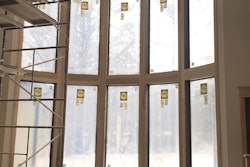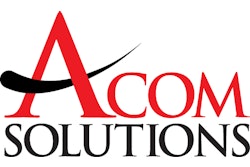Inventory-control software makes sophisticated serialized product tracking available to mom-and-pop shop
Scottsdale, AZ — April 22, 2005 — What do you do when you are an independent electronics store, selling wide-screen TVs, stereos, home theater systems, cell phones, computer equipment and digital cameras, and you have to compete with the likes of Circuit City, Costco, Best Buy and Comp USA?
As a mom-and-pop retailer, you can't come close to the purchasing power of big box chains, and you really can't carry the multiple categories of products — and remain competitive — like these big players either. But smaller electronics retailers are finding other ways to wedge themselves into the market and pull more of that high-end home electronics business into their stores.
Such is the case with independents that are using a new technology solution that, for the first time, gives small stores the ability to manage their point-of-sale (POS) and inventory by serialized units and to a precision only available before to the big chain electronics retailers.
Mom-and-pops Rise Again
It has only been about six or seven years now, since the start of the boom with digital, home computers, cell phones and high-definition TV, that independent home electronics retailers have found a place again in the market. The steamrolling effect of the big box chains in the 1980s had made the mom-and-pop electronics store virtually a thing of the past. In many markets, less that 20 percent of stores survived.
But those that did hang on were fortunate to capitalize on the new and sophisticated home technologies of the late 1990s, filling a niche in the market for consumers who needed educational hand-holding on these new, and somewhat incomprehensible, products like Plasma, LCD and DLP viewing systems. When a customer is ready to spend $10,000 on a new TV, or $25,000 on a home theater system, he is going to ask a lot of questions, and typically the smaller retailer is in a better position to answer those questions than a less-informed salesperson at one of the big discount houses.
This resurgence in business growth for the independent has led to the demand for more sophisticated software applications in point-of-sale and inventory management to help accommodate the requirements and complexity of the electronics systems being sold. Many mom-and-pop shops that were managing their sales and inventory on a manual basis are now finding this inadequate for the upsurge in sales volume and the additional inventory management challenges brought on by the many peripheral components needed to complement a sale and installation of these new systems.
Beefing up POS/Inventory Management
Electronics retailers are also finding that their existing POS/inventory management software is ill-equipped to capably manage serialized tracking of their inventory. Where before this was not quite so necessary, now, when retailers are stocking high-ticket TVs and other electronics items, it becomes a capital issue, where floor dating and other factors come into play.
"We have always kept a very tight rein over our inventory and have been successful in accruing virtually no shrinkage," says George Mamalakis, president of Holser & Bailey Home Entertainment Center in Santa Barbara, Calif. "But we needed an inventory system that could not only track serial numbers but could manage serialized product. Every item that comes into our store now has a life of its own. From the time that it becomes introduced into our inventory, we track the whole history of each individual product: when it was brought into our inventory; what particular [stock-keeping unit (SKU)]; who bought it; and whether it was returned to the manufacturer for repair. We can trace it immediately to the memo that it was processed on. It is just total control over any item."
Holser & Bailey did not always have this capability of inventory control. Like many other electronics retailers, they have experienced a surge in business over the past several years, with 2004 showing their highest sales since the store opened in 1969. Hit hard in the previous years, along with other independents, they are one of two surviving non-chain electronics retailers in the Santa Barbara market, from a total of 19 stores in the early 1980s. But today, George Mamalakis' store is logging record sales of cutting-edge, big screen TVs — the latest in flat-panel Plasma and LCD displays, LCD and DLP projectors, and home theater design and installation. All of this growth has put serious pressure on their POS/inventory management system, forcing them to find a solution.
"This year, so far, we are tracking a 50 percent increase over 2004, and that was our biggest year ever," says Mamalakis. "This means that if we were using our prior point-of-sale and inventory system, we would be pulling our hair out just handling the posting of sales, not to mention trying to generate reports. There were a lot of other processes that we needed to do, that weren't getting done fully with our other set up — reports; information that we needed for tracking sales performance; tracking number of SKUs sold in a period of time; and finding a product by serial number. Just having serial numbers within the scope of the description of the product is one aspect, but being able to do the analysis and data crunching to give us ongoing information, and also information having to do with past sales, is quite another."
Managing Serialized Inventory
The software system that Holser & Bailey now uses is called NevoRetail, a POS/inventory-control program developed by Next Evolution Technologies, a Scottsdale, Ariz.-based developer of computerized management solutions for retailers. Built on technology already in use in the industry, the solution provider has adapted a suite of applications into a complete package to include features that have not been available before to the small retailer. The NevoRetail program was designed to be applicable for both hard-goods and soft-goods retail stores, the solution provider said.
Amongst its capabilities, one of the program's features is a module for management of serialized inventory. It provides document-level tracking of independent product serial numbers for a particular piece of inventory to a level of detail not found in other software applications available to retailers, according to Next Evolution. It tracks the entire history of the serialized unit, everything that ever happened to it: when it was received; what SKU it came in on; when it was physically inventoried; when it was sold; to whom it was sold; on what receipt it was sold; if transferred, where to; and if and when it was returned to the manufacturer for servicing.
This sophistication of serialized inventory management has previously only been available to those that could afford to develop their own customized, and very costly, programs, such as the big box retailers that couldn't function without such close tracking and management of their inventory. Next Evolution said its solution gives the independent store operator the capability to have a system of the same caliber as what is being used by the big box players.
Similarity to RFID
"Structurally, NevoRetail is very similar to radio frequency identification (RFID) in terms of the database," says Eric Thompson, vice president of development for Next Evolution. "When you are using RFID, there is a unique record stored in a database for each of the individual RFIDs that will be found in your store. Similarly, NevoRetail scans for the serial number — the UPC code and the bar code representing the electronic identifying number (EIN code), which is a number totally unique to a specific individual product. It is scanned at the time of reception. If a case of 24 Nokia cell phones arrive at the store to be inventoried, each one of those 24 cell phones are scanned individually. It will essentially link the serial number of each phone to a unique record in the inventory database. And then, from that point on, it knows everything that happens to it.
"Within the framework of serialized inventory control, the program provides for some very useful applications — such as the ability to manage product by actual landed costs for each individual serialized unit," continues Thompson. "When items are received, typical inventory programs will cost same-model product at a calculated average cost, despite the fact that their actual purchase costs may vary. When items are sold, the inventory is relieved at that average value. Because NevoRetail can store the exact dollar amount of an individual serialized item when it landed, it allows for the exact valuation of that specific product throughout its inventoried life cycle. This presents the retailer with a much more specific capability for controlling margins and profits on inventory."
This feature is also useful with floor dating, Next Evolution said. Retailers that are carrying 50-inch, wall-mount, flat-panel LCD TVs, with $10,000 invested per unit into inventory, might find the meticulous, individual-serialized-unit tracking capability a necessity in tightly managing this timely inventory. It will give them a list of all units that they have in stock and how old each unit is on the dating cycle, and it presents the most aged unit to be sold first to the customer.
Integrated the Sales Order
Integrated sales order tracking is another feature that is a vital necessity for electronics retailers, particularly with such complex sales presentations as home theater systems equipment and installation, where multiple big-ticket products and numerous components are part of the package. Where it used to take retailers hours to assemble a complete sales presentation for a home theater system, it now can be done in a matter of minutes, complete with selected serial-individualized components.
"Designing and installing home theater systems is one of the biggest growth areas of our business," says Mamalakis. "One purchase usually represents about 10 to 12 items, with a price range between $5,000 and $30,000, and all of those items have to be written up on a proposal. With careful management of my inventory, when I come back from a customer's home, I have a good idea of what types of product I have in stock that will work best for the home theater experience my customers are desiring. Proposals that used to take me the better part of a day to put together, I can now prepare for my clients in 10 to 15 minutes, with specific serialized product selected and customized notes."
Next Evolution said that Holser & Bailey's NevoRetail sales order system also provides two other key sales and inventory management components. First, a comprehensive fulfillment module, acting as an inventory replenishment mechanism. This system automatically generates purchase orders for the quantity of inventory that is required at a specific date in the future for that sales order, taking into consideration the current inventory on hand, item-for-item. This ensures all components are in stock when the equipment is ready to be delivered, Next Evolution said. And second, a package or kit prompt, where required or optional accessories are presented for inclusion with an equipment purchase. Once the purchase is completed, the system automatically adjusts the inventory status for each component item.
Managing Inventory the Way You Sell It
NevoRetail also provides other modules to outfit the small retailer with big-chain capabilities, including an internal accounts receivables management program that stores all customer information within NevoRetail so there is no delay in accessing a customer's records and balances, with all transactions and balances recorded in real-time. The NevoRetail multi-vendor module lets retailers manage their inventory the way they sell it, but also purchase it the way each individual vendor requires product to be ordered. The solution makes the conversions automatically and for every product and vendor. And a gift card database set up within the retailer's own NevoRetail program lets the shop owner manage their own gift card processing system totally within their own database, with no need for card processing companies or their attendant fees.
Next Evolution said that NevoRetail is ideal for both hard-goods and soft-goods retailers with under five stores. For hardware requirements with one store, any typical PC will work that runs Windows 2000 or Windows XP. With more than five users, a dedicated Windows server (Windows 2000 or 2003) with a single-processor Pentium 4 and 1 gigabyte of memory may be needed. Pricing starts at $2,500 for one store, including one POS site and inventory.
Jim McMahon writes on retail systems and technology.
Additional Articles of Interest
The focus in the retail sector has shifted from managing the movement of goods to managing the information about goods. Read more in "Ramping Up the Retail Supply Chain," in the February/March 2005 issue of Supply & Demand Chain Executive.
For more information on demand planning and forecasting, see the analyst articles in the April/May 2004 and February/March 2005 issues of Supply & Demand Chain Executive.
Scottsdale, AZ — April 22, 2005 — What do you do when you are an independent electronics store, selling wide-screen TVs, stereos, home theater systems, cell phones, computer equipment and digital cameras, and you have to compete with the likes of Circuit City, Costco, Best Buy and Comp USA?
As a mom-and-pop retailer, you can't come close to the purchasing power of big box chains, and you really can't carry the multiple categories of products — and remain competitive — like these big players either. But smaller electronics retailers are finding other ways to wedge themselves into the market and pull more of that high-end home electronics business into their stores.
Such is the case with independents that are using a new technology solution that, for the first time, gives small stores the ability to manage their point-of-sale (POS) and inventory by serialized units and to a precision only available before to the big chain electronics retailers.
Mom-and-pops Rise Again
It has only been about six or seven years now, since the start of the boom with digital, home computers, cell phones and high-definition TV, that independent home electronics retailers have found a place again in the market. The steamrolling effect of the big box chains in the 1980s had made the mom-and-pop electronics store virtually a thing of the past. In many markets, less that 20 percent of stores survived.
But those that did hang on were fortunate to capitalize on the new and sophisticated home technologies of the late 1990s, filling a niche in the market for consumers who needed educational hand-holding on these new, and somewhat incomprehensible, products like Plasma, LCD and DLP viewing systems. When a customer is ready to spend $10,000 on a new TV, or $25,000 on a home theater system, he is going to ask a lot of questions, and typically the smaller retailer is in a better position to answer those questions than a less-informed salesperson at one of the big discount houses.
This resurgence in business growth for the independent has led to the demand for more sophisticated software applications in point-of-sale and inventory management to help accommodate the requirements and complexity of the electronics systems being sold. Many mom-and-pop shops that were managing their sales and inventory on a manual basis are now finding this inadequate for the upsurge in sales volume and the additional inventory management challenges brought on by the many peripheral components needed to complement a sale and installation of these new systems.
Beefing up POS/Inventory Management
Electronics retailers are also finding that their existing POS/inventory management software is ill-equipped to capably manage serialized tracking of their inventory. Where before this was not quite so necessary, now, when retailers are stocking high-ticket TVs and other electronics items, it becomes a capital issue, where floor dating and other factors come into play.
"We have always kept a very tight rein over our inventory and have been successful in accruing virtually no shrinkage," says George Mamalakis, president of Holser & Bailey Home Entertainment Center in Santa Barbara, Calif. "But we needed an inventory system that could not only track serial numbers but could manage serialized product. Every item that comes into our store now has a life of its own. From the time that it becomes introduced into our inventory, we track the whole history of each individual product: when it was brought into our inventory; what particular [stock-keeping unit (SKU)]; who bought it; and whether it was returned to the manufacturer for repair. We can trace it immediately to the memo that it was processed on. It is just total control over any item."
Holser & Bailey did not always have this capability of inventory control. Like many other electronics retailers, they have experienced a surge in business over the past several years, with 2004 showing their highest sales since the store opened in 1969. Hit hard in the previous years, along with other independents, they are one of two surviving non-chain electronics retailers in the Santa Barbara market, from a total of 19 stores in the early 1980s. But today, George Mamalakis' store is logging record sales of cutting-edge, big screen TVs — the latest in flat-panel Plasma and LCD displays, LCD and DLP projectors, and home theater design and installation. All of this growth has put serious pressure on their POS/inventory management system, forcing them to find a solution.
"This year, so far, we are tracking a 50 percent increase over 2004, and that was our biggest year ever," says Mamalakis. "This means that if we were using our prior point-of-sale and inventory system, we would be pulling our hair out just handling the posting of sales, not to mention trying to generate reports. There were a lot of other processes that we needed to do, that weren't getting done fully with our other set up — reports; information that we needed for tracking sales performance; tracking number of SKUs sold in a period of time; and finding a product by serial number. Just having serial numbers within the scope of the description of the product is one aspect, but being able to do the analysis and data crunching to give us ongoing information, and also information having to do with past sales, is quite another."
Managing Serialized Inventory
The software system that Holser & Bailey now uses is called NevoRetail, a POS/inventory-control program developed by Next Evolution Technologies, a Scottsdale, Ariz.-based developer of computerized management solutions for retailers. Built on technology already in use in the industry, the solution provider has adapted a suite of applications into a complete package to include features that have not been available before to the small retailer. The NevoRetail program was designed to be applicable for both hard-goods and soft-goods retail stores, the solution provider said.
Amongst its capabilities, one of the program's features is a module for management of serialized inventory. It provides document-level tracking of independent product serial numbers for a particular piece of inventory to a level of detail not found in other software applications available to retailers, according to Next Evolution. It tracks the entire history of the serialized unit, everything that ever happened to it: when it was received; what SKU it came in on; when it was physically inventoried; when it was sold; to whom it was sold; on what receipt it was sold; if transferred, where to; and if and when it was returned to the manufacturer for servicing.
This sophistication of serialized inventory management has previously only been available to those that could afford to develop their own customized, and very costly, programs, such as the big box retailers that couldn't function without such close tracking and management of their inventory. Next Evolution said its solution gives the independent store operator the capability to have a system of the same caliber as what is being used by the big box players.
Similarity to RFID
"Structurally, NevoRetail is very similar to radio frequency identification (RFID) in terms of the database," says Eric Thompson, vice president of development for Next Evolution. "When you are using RFID, there is a unique record stored in a database for each of the individual RFIDs that will be found in your store. Similarly, NevoRetail scans for the serial number — the UPC code and the bar code representing the electronic identifying number (EIN code), which is a number totally unique to a specific individual product. It is scanned at the time of reception. If a case of 24 Nokia cell phones arrive at the store to be inventoried, each one of those 24 cell phones are scanned individually. It will essentially link the serial number of each phone to a unique record in the inventory database. And then, from that point on, it knows everything that happens to it.
"Within the framework of serialized inventory control, the program provides for some very useful applications — such as the ability to manage product by actual landed costs for each individual serialized unit," continues Thompson. "When items are received, typical inventory programs will cost same-model product at a calculated average cost, despite the fact that their actual purchase costs may vary. When items are sold, the inventory is relieved at that average value. Because NevoRetail can store the exact dollar amount of an individual serialized item when it landed, it allows for the exact valuation of that specific product throughout its inventoried life cycle. This presents the retailer with a much more specific capability for controlling margins and profits on inventory."
This feature is also useful with floor dating, Next Evolution said. Retailers that are carrying 50-inch, wall-mount, flat-panel LCD TVs, with $10,000 invested per unit into inventory, might find the meticulous, individual-serialized-unit tracking capability a necessity in tightly managing this timely inventory. It will give them a list of all units that they have in stock and how old each unit is on the dating cycle, and it presents the most aged unit to be sold first to the customer.
Integrated the Sales Order
Integrated sales order tracking is another feature that is a vital necessity for electronics retailers, particularly with such complex sales presentations as home theater systems equipment and installation, where multiple big-ticket products and numerous components are part of the package. Where it used to take retailers hours to assemble a complete sales presentation for a home theater system, it now can be done in a matter of minutes, complete with selected serial-individualized components.
"Designing and installing home theater systems is one of the biggest growth areas of our business," says Mamalakis. "One purchase usually represents about 10 to 12 items, with a price range between $5,000 and $30,000, and all of those items have to be written up on a proposal. With careful management of my inventory, when I come back from a customer's home, I have a good idea of what types of product I have in stock that will work best for the home theater experience my customers are desiring. Proposals that used to take me the better part of a day to put together, I can now prepare for my clients in 10 to 15 minutes, with specific serialized product selected and customized notes."
Next Evolution said that Holser & Bailey's NevoRetail sales order system also provides two other key sales and inventory management components. First, a comprehensive fulfillment module, acting as an inventory replenishment mechanism. This system automatically generates purchase orders for the quantity of inventory that is required at a specific date in the future for that sales order, taking into consideration the current inventory on hand, item-for-item. This ensures all components are in stock when the equipment is ready to be delivered, Next Evolution said. And second, a package or kit prompt, where required or optional accessories are presented for inclusion with an equipment purchase. Once the purchase is completed, the system automatically adjusts the inventory status for each component item.
Managing Inventory the Way You Sell It
NevoRetail also provides other modules to outfit the small retailer with big-chain capabilities, including an internal accounts receivables management program that stores all customer information within NevoRetail so there is no delay in accessing a customer's records and balances, with all transactions and balances recorded in real-time. The NevoRetail multi-vendor module lets retailers manage their inventory the way they sell it, but also purchase it the way each individual vendor requires product to be ordered. The solution makes the conversions automatically and for every product and vendor. And a gift card database set up within the retailer's own NevoRetail program lets the shop owner manage their own gift card processing system totally within their own database, with no need for card processing companies or their attendant fees.
Next Evolution said that NevoRetail is ideal for both hard-goods and soft-goods retailers with under five stores. For hardware requirements with one store, any typical PC will work that runs Windows 2000 or Windows XP. With more than five users, a dedicated Windows server (Windows 2000 or 2003) with a single-processor Pentium 4 and 1 gigabyte of memory may be needed. Pricing starts at $2,500 for one store, including one POS site and inventory.
Jim McMahon writes on retail systems and technology.
Additional Articles of Interest
The focus in the retail sector has shifted from managing the movement of goods to managing the information about goods. Read more in "Ramping Up the Retail Supply Chain," in the February/March 2005 issue of Supply & Demand Chain Executive.
For more information on demand planning and forecasting, see the analyst articles in the April/May 2004 and February/March 2005 issues of Supply & Demand Chain Executive.


















